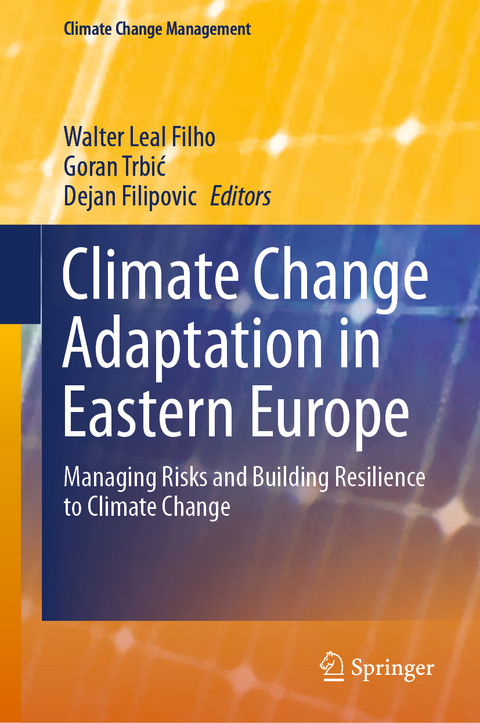
Climate Change Adaptation in Eastern Europe
Managing Risks and Building Resilience to Climate Change
Seiten
2019
|
1st ed. 2019
Springer International Publishing (Verlag)
978-3-030-03382-8 (ISBN)
Springer International Publishing (Verlag)
978-3-030-03382-8 (ISBN)
This book focuses on managing risks and building resilience to climate change, showcasing experiences from research, field projects and best practices to foster climate change adaptation in Eastern Europe that can be implemented elsewhere.
Climate change affects countries in Eastern Europe, i.e. the Western Balkans and Southeast Europe in a variety of ways. Apart from severe floods, there are reports of decreasing water reserves in the southern regions, and of gradual changes in biodiversity and agricultural production. In the South Caucasus area, for instance, climate change models project a decline in precipitation and suggest that it will continue to become drier this century.
Many Eastern European countries, especially the non-EU ones, have weak national climate policies, and transboundary collaborations, as well as limited public engagement in matters related to climate change. As a result, climate change poses a serious threat to their economic stability and development and to the sustainable development of the region.
The above state of affairs illustrates the need for a better understanding of how climate change influences Eastern Europe, and for the identification of processes, methods and tools that may help the countries and the communities in the region to adapt. There is also a perceived need to showcase successful examples of how to cope with the social, economic and political problems posed by floods/droughts in the region, especially ways of increasing the resilience of agriculture systems and of communities.
Addressing this need, the book presents papers written by scholars, social practitioners and members of government agencies involved in research and/or climate change projects in Eastern Europe.
Climate change affects countries in Eastern Europe, i.e. the Western Balkans and Southeast Europe in a variety of ways. Apart from severe floods, there are reports of decreasing water reserves in the southern regions, and of gradual changes in biodiversity and agricultural production. In the South Caucasus area, for instance, climate change models project a decline in precipitation and suggest that it will continue to become drier this century.
Many Eastern European countries, especially the non-EU ones, have weak national climate policies, and transboundary collaborations, as well as limited public engagement in matters related to climate change. As a result, climate change poses a serious threat to their economic stability and development and to the sustainable development of the region.
The above state of affairs illustrates the need for a better understanding of how climate change influences Eastern Europe, and for the identification of processes, methods and tools that may help the countries and the communities in the region to adapt. There is also a perceived need to showcase successful examples of how to cope with the social, economic and political problems posed by floods/droughts in the region, especially ways of increasing the resilience of agriculture systems and of communities.
Addressing this need, the book presents papers written by scholars, social practitioners and members of government agencies involved in research and/or climate change projects in Eastern Europe.
Towards Resilient Cities in Serbia.- Projected changes in multi-day extreme precipitation over the Western Balkan region.- Relationship Between Atmospheric Circulation and Temperature Extremes in Montenegro in the Period 1951-2010.- Analysis of the climate change in the Doboj Municipality and adaptation options.- An Analysis Of Problems Related to Climate Change in Serbian Planning Adocuments.- Climate Change Impact on River Discharges in Bosnia and Herzegovina: A Case Study of the Lower Vrbas River basin.- Water Body Extraction and Flood Risk Assessment Using Lidar and Open Data.
| Erscheinungsdatum | 02.02.2019 |
|---|---|
| Reihe/Serie | Climate Change Management |
| Zusatzinfo | IX, 393 p. 109 illus., 95 illus. in color. |
| Verlagsort | Cham |
| Sprache | englisch |
| Maße | 155 x 235 mm |
| Gewicht | 765 g |
| Themenwelt | Naturwissenschaften ► Biologie ► Ökologie / Naturschutz |
| Naturwissenschaften ► Geowissenschaften ► Meteorologie / Klimatologie | |
| Schlagworte | climate change • Climate change impacts • Climate Change in Southeast Europe • Climate Change in the Balkan • Climate Change in the Caucasus • Climate Change Management • Climate change resilience • Drought in Eastern Europe • Eastern European Climate Policies • Floods in Eastern Europe |
| ISBN-10 | 3-030-03382-1 / 3030033821 |
| ISBN-13 | 978-3-030-03382-8 / 9783030033828 |
| Zustand | Neuware |
| Haben Sie eine Frage zum Produkt? |
Mehr entdecken
aus dem Bereich
aus dem Bereich


